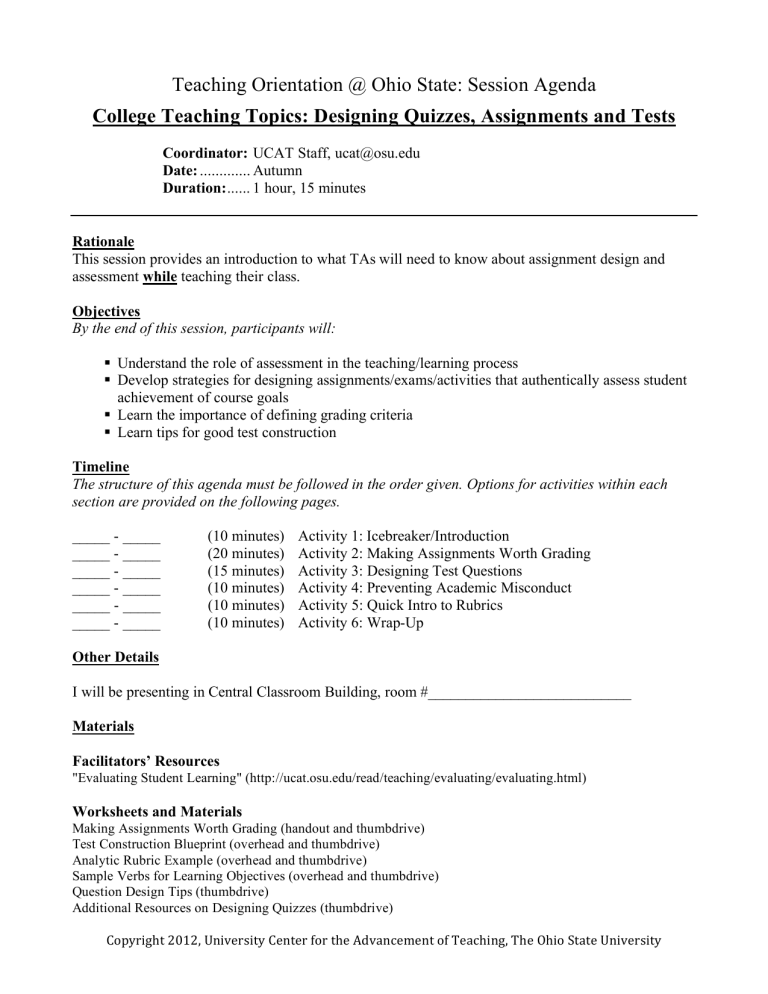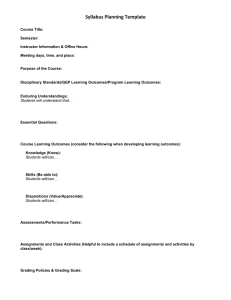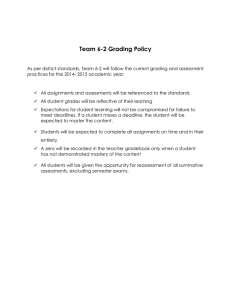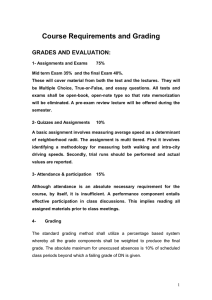Designing Assignments, Tests, and Quizzes

Teaching Orientation @ Ohio State: Session Agenda
College Teaching Topics: Designing Quizzes, Assignments and Tests
Coordinator: UCAT Staff, ucat@osu.edu
Date: ............. Autumn
Duration: ...... 1 hour, 15 minutes
Rationale
This session provides an introduction to what TAs will need to know about assignment design and assessment while teaching their class.
Objectives
By the end of this session, participants will:
Understand the role of assessment in the teaching/learning process
Develop strategies for designing assignments/exams/activities that authentically assess student achievement of course goals
Learn the importance of defining grading criteria
Learn tips for good test construction
Timeline
The structure of this agenda must be followed in the order given. Options for activities within each section are provided on the following pages.
_____ - _____ (10 minutes) Activity 1: Icebreaker/Introduction
_____ - _____
_____ - _____
_____ - _____
_____ - _____
_____ - _____
Other Details
(20 minutes) Activity 2: Making Assignments Worth Grading
(15 minutes) Activity 3: Designing Test Questions
(10 minutes) Activity 4: Preventing Academic Misconduct
(10 minutes) Activity 5: Quick Intro to Rubrics
(10 minutes) Activity 6: Wrap-Up
I will be presenting in Central Classroom Building, room #___________________________
Materials
Facilitators’ Resources
"Evaluating Student Learning" (http://ucat.osu.edu/read/teaching/evaluating/evaluating.html)
Worksheets and Materials
Making Assignments Worth Grading (handout and thumbdrive)
Test Construction Blueprint (overhead and thumbdrive)
Analytic Rubric Example (overhead and thumbdrive)
Sample Verbs for Learning Objectives (overhead and thumbdrive)
Question Design Tips (thumbdrive)
Additional Resources on Designing Quizzes (thumbdrive)
Notes:
__________________________________________________________________________________
__________________________________________________________________________________
__________________________________________________________________________________
__________________________________________________________________________________
__________________________________________________________________________________
__________________________________________________________________________________
__________________________________________________________________________________
__________________________________________________________________________________
__________________________________________________________________________________
__________________________________________________________________________________
__________________________________________________________________________________
__________________________________________________________________________________
__________________________________________________________________________________
__________________________________________________________________________________
__________________________________________________________________________________
__________________________________________________________________________________
__________________________________________________________________________________
__________________________________________________________________________________
__________________________________________________________________________________
__________________________________________________________________________________
__________________________________________________________________________________
__________________________________________________________________________________
__________________________________________________________________________________
__________________________________________________________________________________
__________________________________________________________________________________
__________________________________________________________________________________
__________________________________________________________________________________
__________________________________________________________________________________
__________________________________________________________________________________
__________________________________________________________________________________
__________________________________________________________________________________
Activities
Activity # 1 – Icebreaker
(10 minutes)
Do an icebreaker that gets participants to think about the purpose of assessing student learning. Some possible activities to use here include:
(The following two are parallel activities.)
Start with a ‘Quiz.‘ Ask 3-4 questions (maybe about Ohio State?) that are obscure and unimportant and then debrief. How did taking a quiz make them feel? Do they think their performance on the quiz accurately reflects what they’ve learned the past three days? Why not?
~OR~
Have participants think about good and bad testing or assignment experiences in their schooling. Have them describe what made it good/bad. Highlight examples that demonstrate assessments that did/did not reflect what was important in the course.
Note: Acknowledge that testing/grading are usually the least favorite parts of teaching, and often the most anxiety-producing, but when done well assessment of student learning is central to teaching and learning. We want to think of assessment not just as a way to evaluate students, although it obviously does that, but also a way to guide teaching and student learning toward the course goals. Grading to
Learn
Activity # 2 – Making Assignments Worth Grading
(20 minutes)
Discuss the importance of designing assignments that authentically assess student achievement of course goals rather than simply testing what is easiest to test.
Work through Making Assignments Worth Grading in small groups or pairs (your decision).
Afterwards, have them share examples with the class and discuss how the assessments can teach and reinforce course goals.
Include methods to assess student learning other than tests and papers—emphasizing the importance of fit (i.e. ''Is a multiple choice question the best way of assessing X? What are some other ways you could assess that information?'')
Have them think of both graded and ungraded activities (e.g., Classroom Assessment
Techniques, a worklog in a lab, problem-solving in class, peer-graded problems, etc).
Also make sure to mention scaffolding assignments; that is, breaking up larger projects into smaller components throughout the term to generate more opportunities for feedback and to lessen the end-of-term grading burden.
Activity # 3 – Designing Test Questions
(15 minutes)
Now that they’ve planned what kinds of assignments or tests they might use, work on what kinds of questions or writing prompts would be on those assessments. Talk about the need for a test not only to reflect goals and content, but also to assess a range of student learning.
Introduce the concept of Bloom’s Taxonomy (overhead and verbs handout)
http://www.odu.edu/educ/roverbau/Bloom/blooms_taxonomy.htm
http://www.nwlink.com/~Donclark/hrd/bloom.html
Using one or two of the examples they came up with from activity #2, work through the Test
Construction Blueprint. On an overhead or on the board, come up with examples for various boxes of the blueprint together.
For tips on writing individual questions, refer them to Question Design Tips Handout (on thumbdrive) and Sample Verbs for Learning Objectives (overhead – also on thumbdrive). Using some of the examples from the Test Construction Blueprint you just filled out on the overhead, have them to write good versions of the questions in small groups. You may assign each group a different question, or different types of questions (multiple-choice, open-ended, etc). Debrief by having them share why the type of question is appropriate and any issues they had with how to word the question.
Activity # 4—Preventing Academic Misconduct
(10 minutes)
Now that you've talked about writing specific questinos, ask participants to brainstorm ways to prevent academic misconduct through overall assignment design and implementation. Think about not only tests, but also papers, labs, etc. Some examples:
Create multiple versions of exams so people sitting next to each other don't have the same exam
Be clear about expectations for collaboration and group work
Write new (or slightly different) paper prompts each term. Make content very specific to your course (that is, not the kind of paper that's to locate online).
Scaffold assignments to encourage students to demonstrate process and avoid procrastinating
It's important to not generate paranoia among participants, but rather to encourage them to take a pragmatic approach to preventing misconduct.
Activity # 5 – Grading Criteria
(10 minutes)
Discuss the importance of having criteria for grading. Review grading rubrics and Analytic Rubric
Example . Talk about how determining the criteria ahead of time not only makes grading easier, but also helps teach students what you want them to do. You may also choose to share examples you have used in your own classes.
Use analytic rubric grid (on screen, or draw on board) and using on or two of their earlier examples
(consider choosing groups that weren't used in the previous activity), as a group brainstorm for how you would define excellent, average, and poor performance of that task.
Activity # 6 – Conclusion
(10 minutes)
Wrap-up (make sure and remind them of thumbdrive resources) and answer any additional questions from participants. Thumbdrive resources include:
Evaluations



